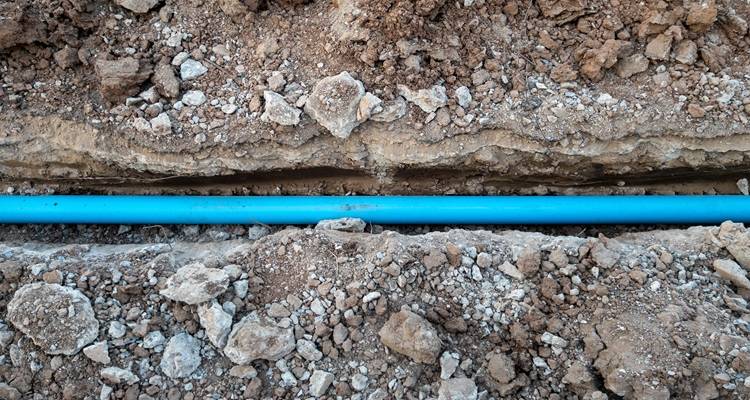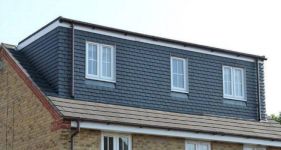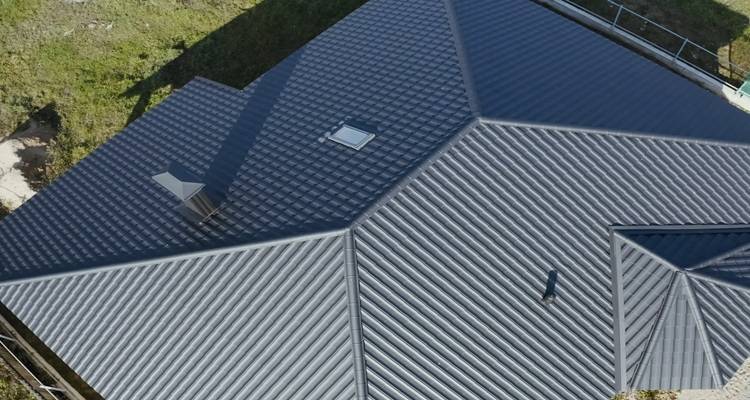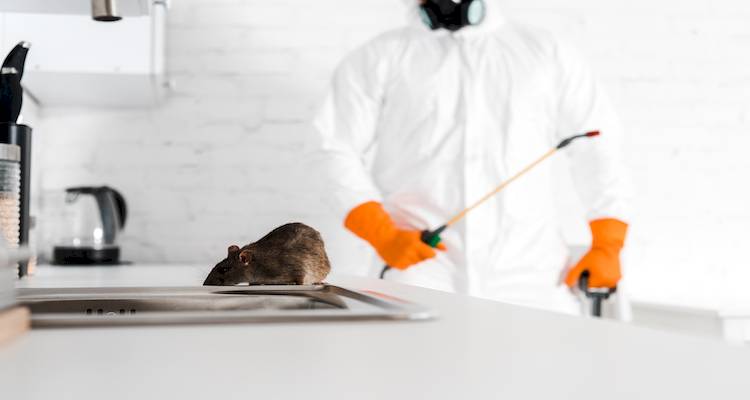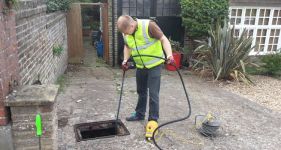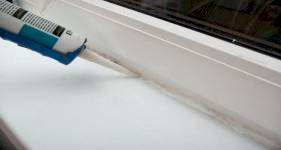House Cladding Cost
- The average cost of cladding a house is around £3,800.
- The job will take approximately 2 - 3 days.
- NEW! Use our house cladding cost calculator for an instant estimate.
- A breakdown of pricing which includes what cladding is, the cost factors to consider and what such a task usually involves.
- How long the job should roughly take and a general overview of what kind of jobs can be performed.
- How to find and hire a cladding fitter.
Want to know how much it costs for external house cladding?
In this guide we look at house cladding prices of different materials such as timber, uPVC and composite, their pros and cons and the cost of hiring a tradesman to fit exterior wall cladding.
On average, you're looking at an overall cost of around £3,800 to install cladding for houses.
In need of a quick quote for your job?
We have a wide range of cladding specialists ready to offer you a free quote!
So, for all the information on house cladding costs, check out the guide below...
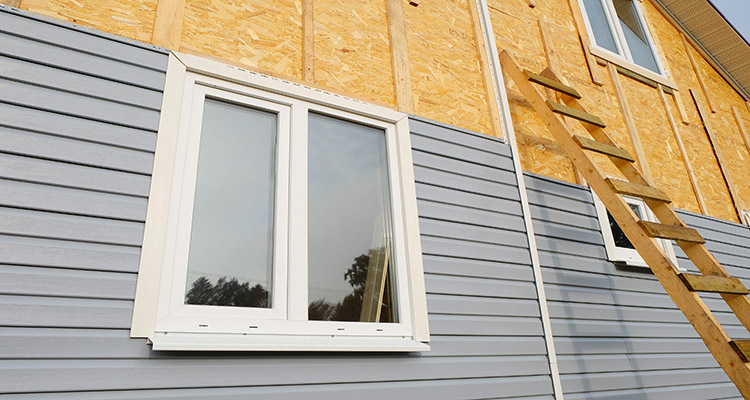
£3,800
Table of Contents
- How Much Does House Cladding Cost?
- House Cladding Prices
- House Cladding Installer Costs
- House Cladding Timescales
- Supply Cost of Cladding a House
- What is Cladding?
- Factors That Impact House Cladding Costs
- How to Fit External Cladding
- Can I Install External Cladding Myself?
- External Cladding Alternatives
- Benefits of External Cladding
- House Cladding Removal Cost
- Checklist: Hiring an External Cladding Installer
House Cladding Cost Calculator
How Much Does House Cladding Cost?
While cladding prices per m² can be between £20 and £300 depending on the material chosen, average costs usually range from £2,800 to £6,000. This includes material and labour costs.
The specific type of external cladding, quality of work, and size of the installation will all affect the price. Labour costs, and the qualification of the tradesman, will also majorly affect the final expense.
Storeys
Single-Storey
A single-storey (Also known as a single floor) property is the simplest and cheapest style of external cladding. Starting prices for a single-storey external cladding begins around £2,800 and go up as far as £5,000, dependent on the size of the property.
For a single-storey single bedroom bungalow, the material alone will cost around £1,500 and if you decide to use high quality premium cladding it will likely increase to around £5,000.
Two-Storey
A Two-storey (Also known as a double-storey) property is a more expensive and more complicated form of external cladding. Starting prices for external cladding on a double-storey property are around £4,000 and go up as far as £6,000, dependent on the size of the property.
For a two bedroom double-storey house, the material alone will costs around £3,000 and if you use a higher quality premium quality cladding, it will increase to around £6,000.
Quality Type
An important factor on the final cost of external cladding is the chosen quality of the materials. There are three standard forms of quality to choose from basic, medium, and premium. Each one adds advantages and disadvantages to the choice of your cladding.
Basic
The basic form of quality standard for external cladding is the most cost effective and quickest construction choice. Basic quality is usually comprised of cheaper costing simple materials.
The main disadvantage of this style is the lack of freedom of choice involved in the customisation of the design and the shorter lifespan. The main advantage of choosing basic quality is that the cost price begins at around £20 per m².
Medium
The Medium form of quality standard for external cladding is still a cost effective and long lasting choice. This form can often cost approximately £50 per m².
The main advantage of this style is the increased level of choice involved in the customisation of the design. Featuring a higher quality material than its basic counterpart, this type of cladding will have a longer lasting lifespan.
Premium
A wide range of materials and a practically limitless level of customisation options are the main features of premium quality cladding. As a result, if a higher quality finish is required, this choice of quality level is a must for those not on a fixed budget.
A premium external cladding costs will begin at around £60 per m² and increase up to £100 per m², depending on the specific materials and brand chosen for the build.
Is it possible to clad over render or does render need removing first? We hate our house's current render and would like modern cladding like composite and wood boards.
House Cladding Prices
| Job type | Duration | Materials | Labour | Approximate costs |
|---|---|---|---|---|
| Small Single-Storey Bungalow (Timber) | 2 Days | £2,100 | £300 | £2,400 |
| Small Single-Storey Bungalow (uPVC) | 2 - 3 Days | £2,900 | £300 | £3,200 |
| Small Single-Storey Bungalow (Aluminium) | 2 - 3 Days | £4,200 | £300 | £4,500 |
| Standard Two Bedroom House (Timber) | 1 Week | £3,500 | £1,000 | £4,500 |
| Standard Two Bedroom House (uPVC) | 1 Week | £4,300 | £1,000 | £5,300 |
| Standard Two Bedroom House (Aluminium) | 1 Week | £5,500 | £1,000 | £6,500 |
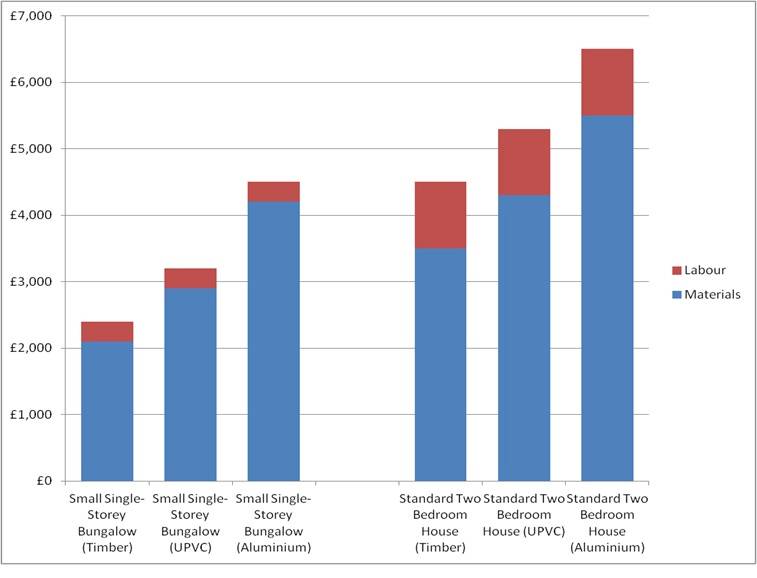
House Cladding Installer Costs
When hiring a tradesman for any type of building work you need to consider what specific jobs actually need doing, as not all tradesmen can handle the same types of work. Installing external cladding can often be performed by multiple different trades.
The most obvious place to start is an external cladding specialist; however, this will depend on your overall budget as a specialist will normally have a higher cost price associated with hiring them. Below is a list of various tradesmen you may require and the jobs they will be able to undertake.
Cladding Specialist
These contractors are hired for the specific installation of external cladding. Using a specialist such as a cladding specialist, who is experienced in external cladding, is often the best option when you want a high quality, long lasting installation.
A cladding specialist's price for labour, usually range from £150 to £200 per day, depending on the complexity of the job, the skills they have, and the experience they bring to the job.
General Builder
A general builder is often used to lead an entire installation project. They can hire and control subcontractors such as labourers in order to complete the work. If on a strict budget a general builder is often the best choice due to the robust nature of their experience and labour price which can be offered.
A general builder will usually cost around £100 to £150 per day to hire, depending on the level of job required, the skills they possess, and the amount of experience.
Carpenter
These tradesmen are hired if you decide to use wooden cladding for your installation. They will often be able to undertake the entire job themselves without the need for further tradesmen, although this will depend on the skills of the aarpenter chosen.
A aarpenter will usually cost you around £125 per day. This will depend on the skills and experience of the tradesman.
Labourers
The most inexpensive form of tradesman, a labourer, should not be overlooked when costing the job. Usually a specialist will provide their own personal labourer; however, even so you should be mindful of the costs to hire them. The day rate of a simple labourer will usually be £50 to £60 per day.
They are used for all the heavy lifting work, moving materials, and jobs, which do not require a specific skill.
House Cladding Timescales
One of the most important factors when considering any building work is obviously timescale. No one wants a job that drags on indefinitely with no idea of when it will be completed. Also the longer a project takes to complete, the greater the final price.
External cladding is no exception. Second to this is the price of labour. However, timescale has a direct effect on the cost of labour, as the longer a job takes, the longer you will be required to pay your selected tradesman.
There are multiple factors, which can affect the timescale. The most obvious being the complexity of the chosen external cladding installation, the size of the property, and the final quality of the work.
Choosing to install cladding over two storeys will take longer than a single-storey, at around 1 week compared to 2-4 days.
A large single-storey cladding installation will take longer than a small single-storey, at around 2 days for a small compared to 4+ days for the large.
However, these factors will also depend on the level of complexity in the plan, the skills the tradesman possess, and the amount tradesmen needed to be hired for the project.
| Tradesman | Time Needed (days) | Cost per Day | Total Labour Cost |
|---|---|---|---|
| Cladding Specialist | 2 - 7 days | £150 | £300 - £1,050 |
| General Builder | 2 - 7 days | £100 | £200 - £700 |
| Carpenter | 2 - 7 days | £125 | £250 - £875 |
| Labourer | 2 - 7 days | £50 | £100 - £350 |
Supply Cost of Cladding a House
The cost of external cladding supplies will vary depending on your choices. Beyond the main construction method, the differing styles of cladding materials will also majorly affect the price.
Timber Cladding Prices
Timber cladding is by far the cheapest option for this type of project. Depending on the size of the building and design of cladding chosen, the number of boards needed varies.
These timber boards will vary in cost depending on the chosen timber, however the price will start at around £20 per m², equating to just under £5 per board. However, depending on the size of your home, the total cost of boards for an average sized property will come to over £3,000 (not including any additional materials required as part of the installation).
uPVC Cladding Prices
Installing uPVC cladding is the standard choice when it comes to the style of cladding used on modern houses, especially in wetter weather climates. uPVC comes in a multitude of colours, lengths, and even shapes. The cheapest option for uPVC cladding comes in white and is the most common type used.
This choice of cladding is usually around £20 to £50 per m², and most commonly sold in packs of 25m², 50m², 75m², and 100m². A standard single-storey small property will take on average around 600 to 1000 uPVC boards, depending on the complexity of the property's external construction.
Aluminium Cladding Prices
Aluminium cladding is the premium choice when it comes to the style of cladding used on modern houses. Aluminium comes in a multitude of finishes, lengths, and even shapes. The cheapest option for aluminium cladding comes in white or silver, with white being the most common type used on modern houses.
This choice of cladding usually costs around £50 to £100 per m² and is available in whatever customised amount is required. Much like uPVC cladding, the standard single-storey small property will take on average around 600 to 1000 aluminium boards, depending on the complexity of the properties external construction.
What is Cladding?
Being a layer of material fixed to the external walls of a house, in order to help protect the building from rain and other weather conditions, cladding is a common method of weatherproofing a property.
The main reason for installing cladding to the exterior of a property is to resist water and the weather.
However there are also other benefits. By adding a layer/skin to the exterior of a building you can improve insulation, and depending on your chosen material, increase fire resistance and may offer additional protection against the elements.
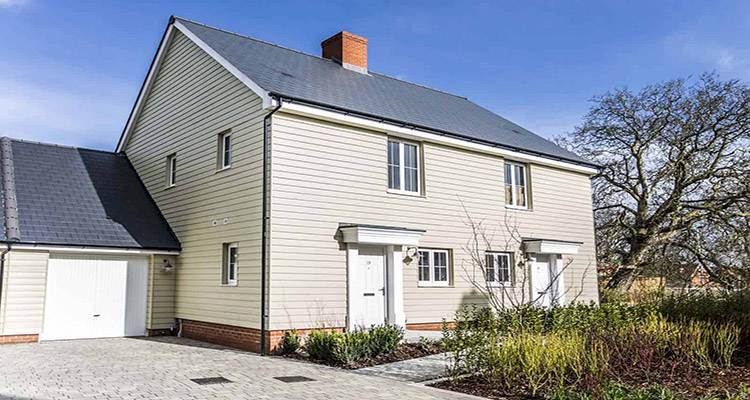
Cladding comes in a variety of materials. Traditionally cladding was made from wooden planks fixed to the exterior forming a layered skin with the appearance commonly associated with the modern day shed.
More recently uPVC and aluminium have become a widely available and popular choice for materials.
These new materials can often come in a variety of different finishes and colours, and rather than overlapping they are often designed to fit together similar to tongue and groove flooring.
Although not as common in the UK, cladding has been slowly increasing in popularity in recent years due to the cost effective nature when compared to other weatherproofing options such as rendering a property.
Factors That Impact House Cladding Costs
As with any home renovation project, there are a number of cost factors to consider when having work carried out on your external cladding or rendering.
Labour Costs
The cost of labour takes the largest chunk out of your building budget. However, the other expenses, such as materials, will take up the other main portion of costs. Materials can often easily surpass the price of labour, if only good quality materials are chosen for the project.
Type of Material
The end look of a cladding installation can often be customised to the individual desires. As well as a choice of materials available, you also need to decide upon colour, design and even shape of the final finish - potentially combining more than one option.
Planning and Budgeting
The planning of your cladding carefully and correctly will determine many factors throughout your project. However, it is always best to keep a budget in mind before beginning preparations and buying any of the materials so you're not faced with any unexpected expenses.
Size of Property
The size of the property to be clad will obviously have a major effect on the final price. A small double-storey building will usually cost almost twice as much as a single-storey, although proportionally it may be less. A double-storey standard sized two bedroom property cladding project will usually begins at £3,800, and the single-storey matching equivalent would begin at around £2,800.
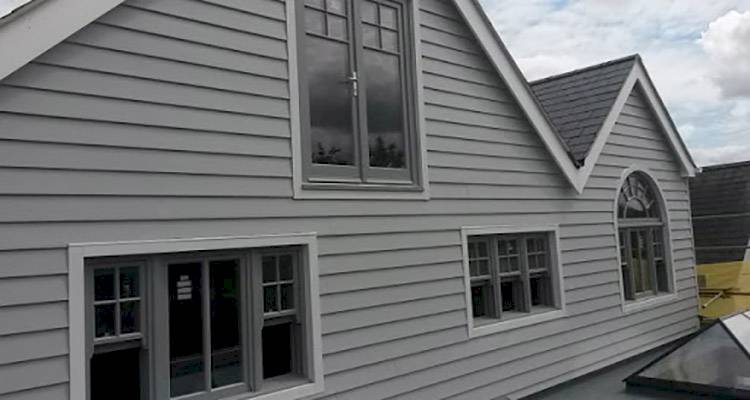
Quality of Cladding
The desired quality of the cladding installation will also factor into the final cost of the project. For a single-storey standard sized UK bungalow completed to a basic standard of quality will begin at around £2,800. However, for the equivalent medium and premium quality builds it would increase the price to £3,500 and £4,500 respectively.
Waste Disposal Costs
Also a major, often overlooked, cost factor to consider before the project is started is waste disposal. Waste disposal, both during and after a construction project, should always be accounted for in the budgeting stage. Waste disposal will usually consist of hiring a skip.
A skip is a large metal container used like a bin, for the disposal of building waste. Skip hire begins at around £150 for a single skip hired for a week. Included in the price of the hire, is usually the cost of collection and disposal of the waste.
How to Fit External Cladding
Budgeting
The first step as with all construction project, no matter the size, is going to be planning a budget. This is a vital step, as there is no point starting a project you cannot afford to complete it. Factors such as materials, labour, and additional expenses need to be calculated at this stage.
Planning
In the planning stages, you will need to decide what the final outcome of the installation is to be, the style of cladding you are going to install, and the types of tradesmen you will have to hire.
This plan will allow you to see an approximate cost for the materials, the tradesmen required, and the permissions needed in the construction. This in turn will allow you to stay within your planned budget or update it if necessary.
Quotes
Quotes are arguably the most important phase of any construction project, as not all tradesmen charge the same rates for the same job. It is always best to get at least three quotes from three different companies, in order to ensure you are getting the very best for your money.
If you are unsure of the tradesmen you will require, this is a great time to ask question to the companies quoting. Use the quotations to research how the build will take place and help you to decide if you require different tradesmen than you originally planned.
Measuring
Now the actual work begins. Firstly, the areas to be clad will need to be measured. This is extremely important and care should be taken to ensure accuracy. These measurements will then be used to help decide on the amount of cladding needed, the lengths of the cladding and the final aesthetic of the project.
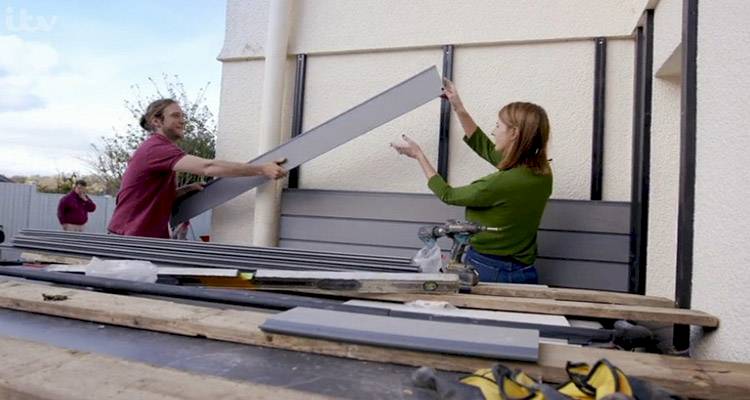
Fitting the Cladding supports
With the walls now measured and the cladding purchased, it is time to fix the supports to the surface which is to be clad. This step can vary depending on the style of cladding chosen. However most will involve fixing long vertical batons (often timber) to the surfaces, to create an air-gap between the final cladding and the walls.
These batons should start around 15mm - 20mm from the ground, should be no more than 600mm apart, creating a minimum cavity of 38mm or more between the cladding and the wall.
Installing the Cladding Boards
Once the supports have been fixed into place the next step is to attach the first cladding board to them. This will begin at the lowest point, making sure of at least a 20mm gap between the board and the ground.
Once the first or lowest level of boarding has been fixed to the supports the second level should be clipped into the first and then attached to the supports following the same process as the first. This is then repeated until the entire surface has been covered as required.
Finishing and Fascias
Finally once the cladding boards have all been fixed to the supports you will often require fascia boards to be screwed into place. This fascia will cover the last cladding boards fixing groove and create a top barrier sealing the edges of the cladding.
Also a corner trim can now be added to cover any corner joints, window edges, or door frames as required. Both finishes can be simply drilled and screwed into place directly into the supporting batons.
Can I Install External Cladding Myself?
DIY is not always an option. A basic external cladding installation can in fact be performed the "do it yourself" route. However, this is by no means a simple undertaking and will require extensive planning to complete.
Measuring needs to be near perfect, specialist equipment such as the the cost of hiring scaffolding also needs to be considered for a two-storey property, and even choosing the correct cladding is really important. So, unless you are the type of person that just has to do it yourself, it will more than likely be a cheaper option to simply hire a qualified and skilled tradesman.
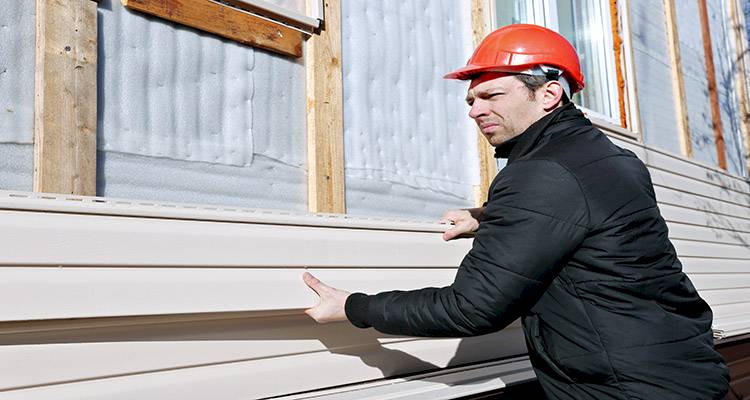
Hiring a tradesman to install external cladding does not mean you cannot attempt various tasks yourself. For example you are still able to measure the sections, and then compare your measurements with the ones taken by the builders.
You could even discuss with the tradesmen you have hired if you are able to assist them and try installing various sections alongside their guidance, leaving the difficult installation parts to them.
External Cladding Alternatives
If you do not like the aesthetics of cladding then there are alternatives to using external cladding to protect your building from the weather; these can be as simple as using specialist paints to provide a minimum protection or even a full render to provide maximum protection from the elements.
It is always best to investigate the advantages and disadvantages of each method before deciding on the process.
However, budget will usually be one of the deciding factors as rendering or cladding an entire property is rarely a cheap process to undertake, and there are cheaper options available on the market for those on a fixed budget.
House Painting Cost
Painting your home without providing a good stable base protection, such as render or cladding, will not afford the same levels of weather protection as if performed with render or cladding.
Wooden cladding can, if not treated correctly, be a pain to maintain in wetter climates.
Paint is by far the cheapest option for external weatherproof coverings of properties. Prices for specialist external house paint costs around £10 - £15 per m².
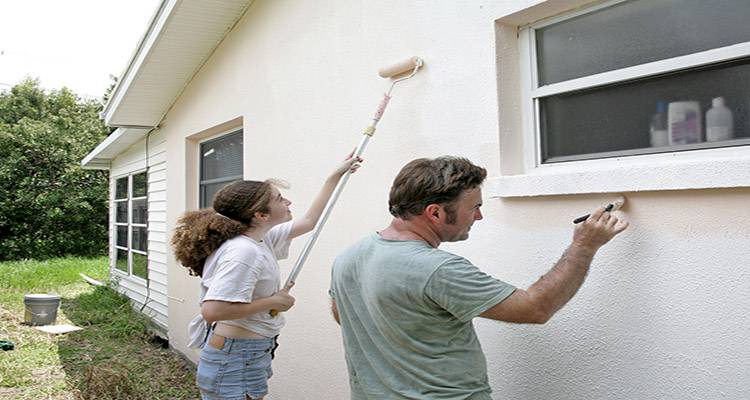
House Rendering Cost
Rendering is at a similar price point when compared to high quality cladding. Costing around £25 - £50 per m², it is the most popular form of weatherproofing used in the UK.
One of the reasons for its popularity is the lack of upkeep and need for maintenance, generally speaking only needing a clean once a year. Whereas some timber and composite cladding may need more regular work in order to keep it looking fresh.
The disadvantage to rendering a building is the time it takes to complete the project (up to 2 weeks) and the mess which the process can create. The final aesthetics of render are also quite bland when compared to the options of finishes available for cladding.
Benefits of External Cladding
As mentioned in previous sections, external cladding is mainly applied to increase the weather resistance of the property, reducing the cost and difficulty of maintenance which is required.
Cladding is simply a good solution to reducing the amount of moisture that is absorbed into the brick work, which can help prevent damp issues.
Also cladding has various additional benefits, such as an increase to the insulation levels of the property. This in turn can be a good way of not just saving money but decreasing the environmental impact of your home.
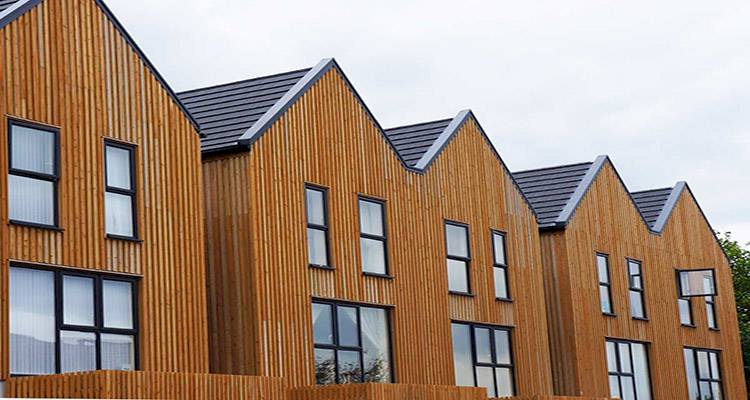
Not only do you have the advantages of saving money and time on maintenance, saving money on heating, and reducing the ageing process of your home; external cladding helps reduce the risk of damp penetrating your walls.
Damp and mould are a big concern when owning a home. Not only can they be unsightly and off putting to look at, they form a substantial health hazard. Once damp and mould has infected a property they can be a costly nightmare to get rid of, and therefore prevention is often a lot simpler than a cure.
Cladding as a result forms the first barrier against such invasions. With a good quality, well-maintained cladding layer, water and moisture cannot permeate the exterior of the home, stopping damp from ever entering your walls themselves.
House Cladding Removal Cost
The removal of external cladding should be considered before it is ever installed, as you may one day wish to remove it.
Whether you no longer like the aesthetics of the cladding, or you decide you want to render your exterior walls, there are a number of reasons to remove external cladding.
In addition, if you have old dilapidated cladding already on your property you may wish to replace it with a newer, nicer looking installation, as this may be reducing your overall property value.
A single-storey external cladding installation can usually be torn down by a confident person; however, it may be too complex for someone inexperienced. Regardless of size and type of cladding installed it will require a few basic elements, such as a skip or waste removal, labour, and basic cleaning supplies.
Skip hire will usually cost around £200 for a single skip, hired for a week, with pick up and disposal. A single skip may not be large enough for all the waste created by removing a full cladding installation.
Usually when removing a full building cladding installation you will be best served in hiring a tradesman such as a general builder. They can usually provide all the tools needed and even dispose of the waste produced.
An average builder will be able to complete the removal project of a standard two-storey house, fully clad, within a 4 to 7 day period. This means it would cost you an average of £2,000, including the skip hire costs and labour.
Checklist: Hiring an External Cladding Installer
Below are several questions to ask yourself when looking for a tradesman to install external cladding or any rendering work required.
- Is your chosen tradesmen qualified? Depending on the tradesman hired, these can be in the form of CSCS certification, City and Guild levels, or even college gained qualifications such as HNC’s.
- Do they have public liability insurance? Make sure they at least have third party liability, which covers building work. Although not a legal requirement, you should find a tradesman who already has insurance in the event of personal injury or accidental damage.
- Does the tradesman offer any guarantee? It can be worth looking for a tradesman who offer a five year guarantee or more. Then if any problems arise in the future, due to any faults in the building process, you are covered and they will fix their mistakes at no expense to you.
- Have you seen evidence of previous work? This is always a good consideration when hiring any tradesman. Whether it's references from previous clients, photos, a portfolio of their work or examples and reviews on MyJobQuote, these will all help in your decision.
- Have you asked for more than one quote? With MyJobQuote you can find more than one company for the same job, as such it's always recommended to have several quotes to compare. Always receive them in writing and with a breakdown of everything included in the cost.



